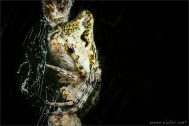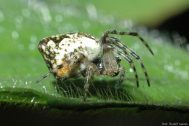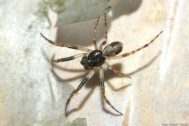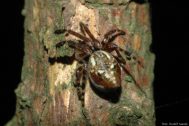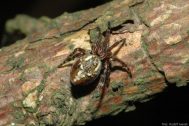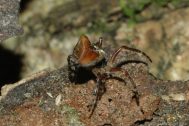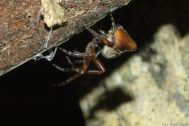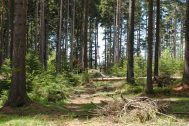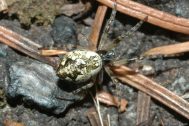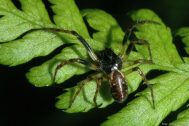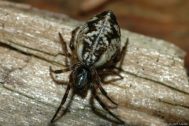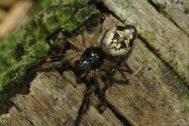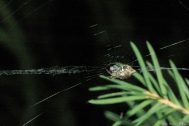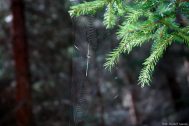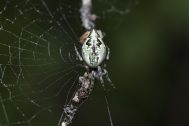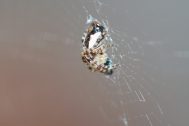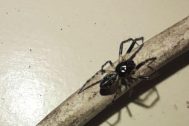| Records by time | |||||
|---|---|---|---|---|---|
| Araneidae | 0-1900 | 1901-1950 | 1951-2000 | 2001+ | ∑ |
| Cyclosa conica (Pallas, 1772) Not endangered | 7× | 14× | 158× | 96× | 275× |
Cyclosa conica (Pallas, 1772)
| Czech name | křižák vířivý |
|---|---|
| Threat level | Not endangered |
| Records | 275 nálezů, 147 kvadrátů |
| First record |
1859, F. Prach, Prach 1866 |
| Last record | 2025 , Ondřej Machač |
| Distribution area | Holarctic (Af. |
| Phytogeographic area |
|
| Původnost stanovišť |
|
| Humidity |
|
| Stratum |
|
| Osvětlení stanovišť |
|
| Hojnost výskytu |
|
| Altitude | 150-1300 |
Bibliography
Host utilization of koinobiont spider-ectoparasitoids (Ichneumonidae, Ephialtini, Polysphincta genus-group) associated with Cyclosa spp. (Araneae, Araneidae) across the Palaearctic.
Most parasitoid wasps establish close interactions with their host taxa, and polysphinctines (ichneumonid koinobiont spider-ectoparasitoids) are no exception. Two polysphinctines, Zatypota picticollis and Reclinervellus nielseni, are, respectively, partial and exclusive parasitoids of Cyclosa spp. (Araneidae), which build an orb web with web decoration. The main aim was to investigate the host association of these wasps, including the behavioural alteration of spider hosts across two sides of the Palaearctic (Central Europe vs. Japan).
R. nielseni was associated with relatively common local species of Cyclosa both in Europe (Cyclosa conica), sharing these with Z. picticollis, and in Japan (C. argenteoalba). We also found a new alternative host spider, Cyclosa laticauda, in Japan.
Host web alterations were observed in all parasitoid-spider interrelationships. The alteration patterns of the two polysphinctines have a similar constructional plan that exploits pre-existing frame lines for the cocoon webs; however, they differ partially in their radii, which are either straight or zigzag shaped and in hub loops present or absent. This indicates that certain differences in the neurophysiologic changes in the spider host occur depending on the parasitoids. The fluffy decoration induced in C. argenteoalba manipulated by R. nielseni was not found in Cyclosa conica or C. laticauda, probably because of its non-innateness.
The cocoons of R. nielseni had four conspicuous long ribs making the cocoon quadrate in cross-section regardless of the host spider species or region; such ribs do not appear in two co-generic species.
Křižák vířivý – evropský pavouk roku 2016.
V tradiční anketě zaměřené na popularizaci různých druhů živočichů vybralo 78 arachnologů z 26 evropských zemí tentokrát za pavouka roku 2016 křižáka vířivého (Cyclosa conica). Čeleď křižákovití (Araneidae) čítá 3100 dosud popsaných druhů, z nichž 131 známe i z Evropy. Rod Cyclosa je ve střední Evropě zastoupen dvěma druhy.
Gallery
Statistics
By month
By altitude
By collecting method (274 used records)
| Cyclosa conica (Pallas, 1772) ES | Males | Females | Juveniles | Records |
|---|---|---|---|---|
| Pozorování | 0 | 1 | 4 | 6 |
| Individuální sběr | 18 | 32 | 28 | 63 |
| Smyk | 15 | 17 | 20 | 38 |
| Fotografie | 2 | 10 | 1 | 8 |
| Sklepávání | 8 | 8 | 45 | 39 |
| Neurčeno | 28 | 32 | 3 | 87 |
| Prosev | 3 | 2 | 5 | 9 |
| Nárazová past | 2 | 0 | 0 | 2 |
| Zemní past | 8 | 13 | 4 | 22 |
| Males | Females | Juveniles | Records |
By biotope (274 used records)
| Cyclosa conica (Pallas, 1772) ES | Males | Females | Juveniles | Records |
|---|---|---|---|---|
| Lesy | 0 | 0 | 2 | 3 |
| Zahradnicky utvářené zahrady a parky | 1 | 0 | 2 | 3 |
| Horské smrčiny | 3 | 3 | 3 | 7 |
| Lesostepní doubravy | 2 | 3 | 1 | 6 |
| Výsadby jehličnanů | 3 | 15 | 11 | 26 |
| Paseky | 0 | 0 | 6 | 2 |
| Suťové a roklinové lesy | 0 | 2 | 9 | 5 |
| Kamenolomy | 0 | 2 | 1 | 3 |
| Vřesoviště nižších poloh | 1 | 0 | 0 | 1 |
| Neurčeno | 31 | 38 | 12 | 100 |
| Lesní okraje | 5 | 5 | 11 | 9 |
| Podmáčené smrčiny | 0 | 1 | 8 | 4 |
| Bylinné porosty břehů | 2 | 1 | 3 | 4 |
| Mokré louky | 2 | 2 | 2 | 6 |
| Reliktní bory na skalách | 2 | 3 | 6 | 10 |
| Rašeliniště | 7 | 3 | 7 | 14 |
| Výsadby listnáčů | 1 | 8 | 2 | 5 |
| Vlhké lesní lemy | 0 | 1 | 0 | 1 |
| Přirozené lesy | 0 | 4 | 0 | 3 |
| Močály | 1 | 0 | 1 | 2 |
| Lužní lesy nížin | 1 | 1 | 2 | 5 |
| Bučiny nižších poloh | 2 | 2 | 3 | 6 |
| Těžebny písku a jiných nezpevněných hornin | 0 | 1 | 0 | 1 |
| Lesní cesta | 0 | 2 | 0 | 2 |
| Lesy | 1 | 4 | 1 | 5 |
| Suché lesní lemy | 1 | 0 | 0 | 1 |
| Kamenité suti nižších poloh | 1 | 5 | 0 | 6 |
| Okraje silnic | 1 | 0 | 0 | 1 |
| Stinné skály nižších poloh | 0 | 1 | 0 | 1 |
| Horské bučiny | 0 | 1 | 4 | 2 |
| Lesy vyšších poloh a strmých svahů | 1 | 1 | 3 | 4 |
| Louky | 2 | 1 | 0 | 3 |
| Ostřicové porosty stojatých vod | 0 | 1 | 3 | 3 |
| Suché doubravy | 3 | 1 | 3 | 6 |
| Mokřadní olšiny | 0 | 0 | 2 | 2 |
| Skalní a suťové biotopy | 0 | 0 | 1 | 1 |
| Suché křoviny | 1 | 0 | 0 | 1 |
| Břehy tekoucích vod | 0 | 0 | 1 | 1 |
| Pastviny | 2 | 0 | 0 | 1 |
| Písčiny | 0 | 1 | 0 | 1 |
| Obhospodařované pozemky | 1 | 0 | 0 | 1 |
| Luční ostřicové mokřady | 2 | 0 | 0 | 2 |
| Rákosiny a orobincové porosty stojatých vod | 2 | 1 | 0 | 1 |
| alpínské trávníky | 2 | 0 | 0 | 1 |
| Suché louky | 0 | 1 | 0 | 2 |
| Males | Females | Juveniles | Records |


